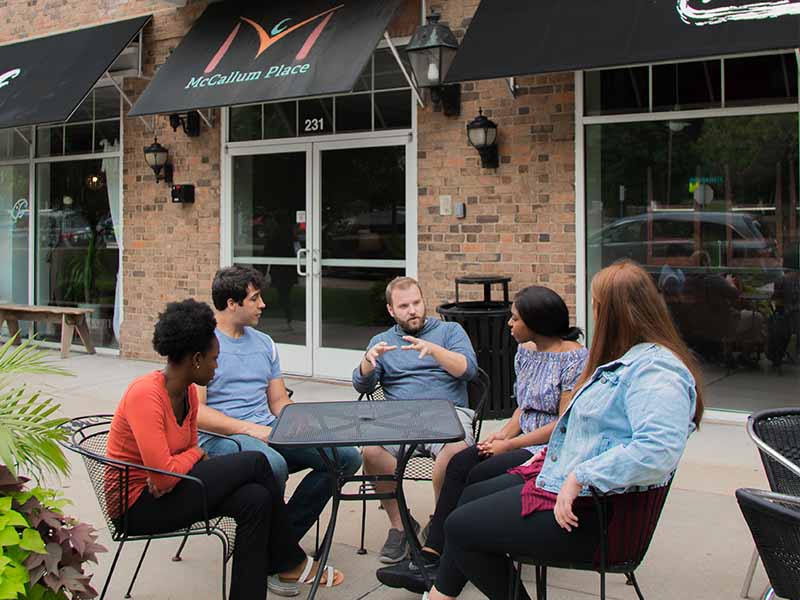Caroline Leibman, MA, NCC, BC-DMT, SEP
Individual Therapist; Dance & Movement, Expressive & Psychodrama Group Therapist
Movement is our first language. Before we had access to language we spoke with our bodies. We used gesture, posture and sound to communicate our wants and needs. If you have been around an infant or toddler lately you know how effective “body language” is. For all of us, communication began through embodiment. We expressed our emotional wants and needs, and ideas/thoughts on a body level.
The field of sensation in our bodies is a constant source of information which when noticed relays clear communication regarding our wants, needs, emotions, and thoughts/ ideas. Sensational cues hold the roots of our life experiences. Clarissa Pinkola Estes, a gifted Jungian analyst writes, “The body remembers, the bones remember, the joints remember, and the little finger remembers. Memory is lodged in pictures and feelings in the cells themselves. ” (Estes, 1992, p.200)
Unfortunately, for most people with Eating Disorders the relationship with one’s body is constantly under attack. It is the field upon which the acts of restricting, binging and purging take place. It also becomes the enemy. Whether it is because the effects of malnutrition and unwholesome eating patterns lead to body image dysmorphia, or because a client’s chronic dysregulation sets the stage for eventual self-loathing, the body becomes the enemy and is ultimately left behind.
There is no way to recover from an Eating Disorder without involving Creative Arts therapies such as Dance/Movement Therapy and Authentic Movement in the treatment continuum. These body-based/somatic approaches offer ways to gradually lead a client toward inhabiting the body so that s/he can re- experience the resources and gifts that come from being embodied.
At McCallum Place, Dance/Movement Therapy and Authentic Movement are group therapies that each client receives as a part of treatment. These groups are offered to foster and enable a safe return and re-experiencing of the body. These practices are somatic in nature. Somatic practices are mindful and emphasize the mind-body connection, allowing a client to focus on his/her personal and physical experience as it unfolds moment to moment while attending to the breath. Somatic practices invite presence and personal attunement as a client engages in the movement process.
Dance/Movement Therapy is the psychotherapeutic use of movement as a process which furthers the cognitive, emotional, physical and spiritual development of an individual. It is founded on the notion that the mind and body are united and a dynamic relationship exists between motion and emotion. A client is invited to allow his/her body to express inner emotional states, conflicts, thoughts/meanings and invite sensational impulses to be expressed. Through movement and dance, the client is invited to express what is present and explore a more varied vocabulary of movement. In doing so, the client can become more securely balanced, and experience increased spontaneity and well-being while being embodied.
Helping a client regain a sense of wholeness by experiencing the fundamental unity of the mind, body and spirit is an important aspect of recovering from an Eating Disorder. Dance/Movement Therapy fosters an increase in body awareness, encouraging more accurate body image; allows for the safe expression of strong affect; invites a re-connection with play, spontaneity and joy; restores splits in the body-mind connection, and nurtures grounding and safety in the body.
Christine Caldwell, Somatic Psychotherapist and Dance/Movement Therapist so aptly states when describing the benefits of Dance/Movement Therapy, “ We regain lost parts of self through acceptance and embodiment of our experiences. When we tell the truth about these experiences, we access our authentic self, our essence. We also liberate the tremendous wellspring of energy that is stored there.” (Caldwell, 1996, p.149)
Authentic Movement is a completely self-directed form of moving and being moved that invites a deep attunement to and dwelling within the body. Each client in this form is invited to close his/her eyes and mindfully attune to three levels of inner experience: imagination, emotion and sensation. Whether resting in stillness or moving with eyes closed, this process allows a client to experience a more intimate awareness of his/her body while utilizing and strengthening mindful and compassionate witnessing. The benefits of practicing this discipline are many. Each client has an opportunity to experience the internal landscape of the self. Compassion, intimacy, empathy for the self and mindfulness are nurtured. Through moving and witnessing, less conscious as well as unconscious material in the body can emerge and made more visible and tangible. Each client has an opportunity to experience the sacred, and one’s creative source found in the body.
Janet Adler, author, teacher and founder of the Discipline Authentic Movement writes, “ The body is our sensation, our felt emotion. The body is our experience of ourselves, our temple in which the light of our spirit burns. (Adler, 2002, p.6)
Recovering from an Eating Disorder is hard work! It cannot be done if the body is left behind. Dance/Movement Therapy and Authentic Movement are two ways, alongside Yoga Therapy, Mindful Walking and Somatic Experiencing interventions that are offered in our continuum of care. At McCallum Place we long to insure that each client has opportunities to return, renew and recover a healthy and caring relationship with one’s body to help nurture a strong, resilient and lasting recovery.
References:
Adler, J. (2002). Offering from the Conscious Body, The Discipline of Authentic Movement. Rochester VT: Inner Traditions.
Caldwell, C. (1996). Getting Our Bodies back. Recovery, Healing and Transformation through Body-Centered Psychotherapy. Boston MA: Random House, Inc.
Estes, C. (1992). Women Who Run with the Wolves. NY New York: Ballantine Books.









